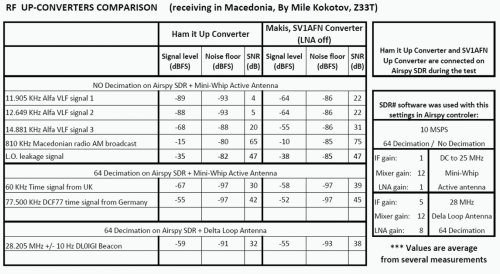Comparing the Ham-It-Up Upconverter with the SV1AFN Upconverter
Over on YouTube user Mile Kokotov has uploaded a video showing a comparison between the ham-it-up and SV1AFN upconverters. An upconverter allows reception of VLF to HF signals with SDR dongles such as the Airpsy and RTL-SDR.
Mile shows that both the ham-it-up and SV1AFN upconverters use the same core component, a double balanced mixer ADE-1. However, the ham-it-up comes with the option for a noise circuit to be populated. A noise circuit is useful if you want to measure the response of a filter or antenna for example. With the ham-it-up the noise source components are sold seperately and need to be carefully soldered on.
On the other hand the SV1AFN upconverter comes with a built in selectable LNA and better filtering circuitry. The SV1AFN upconverter also uses the ADE-1 in a slightly different design compared to the ham-it-up which allows for much improved performance at VLF frequencies.
In the results Mile uses his Airspy and shows that the SV1AFN upconverter is significantly better at receiving VLF frequencies, and also better at receiving a 28.205 MHz beacon. The results are summarized in the table captured from the video shown in the image below. In the second video Mile also compares the local oscillator drift of each upconverter.

Like the man said, both of these converters only have a low pass filter (e.g. to prevent strong out of band VHF interference, such as FM broadcast stations), leaving VLF and HF reception vulnerable to in band interference (e.g. from strong signals, such as AM broadcast signals). With proper input filtering, these converters would perform a lot better.
Additionally, when the RF signal is connected to the DBM IF port, the linearity will not be as good as with the input signal connected in the conventional manner. Also, there is a danger that transients at the RF port (previously the IF port) can damage the diodes internal to the mixer (e.g. from Mini-Circuits RF Designer’s Handbook).